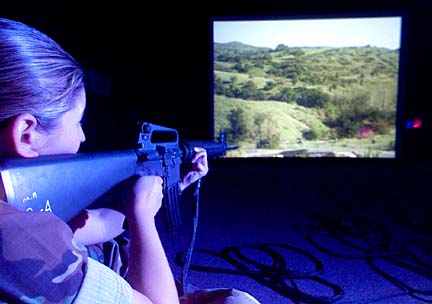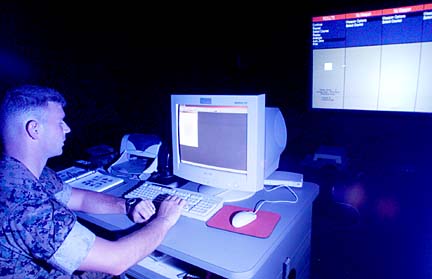
KEN IGE / KIGE@STARBULLETIN.COM
Cpl. Jennifer DiGuglielmo "fires" an M-16 at a virtual target range on the Firearms Training System, or FATS, at Marine Corps Base Hawaii at Kaneohe. Soldiers can work "live" on marksmanship as well as different combat and policing scenarios. A pneumatic system even simulates recoil on the guns.
Virtual warfare
Weapons simulators help
Kaneohe Marines hone their
skills in different scenarios
Dug in high on Hill 231, Kaneohe Bay Marine Cpl. Jennifer DiGuglielmo and her unit receive an order to slow the advance of an enemy patrol about a mile away and inching its way to their position.
She scans the horizon for the enemy soldiers through the sights of her M-16 rifle. She hears the crackle of a radio report from a nearby observation post calling for "immediate suppression" fire. Within seconds, DiGuglielmo opens fire as the enemy soldiers break their cover and move on to an open dirt road. Mortar rounds fall within their ranks, kicking up small puffs of smoke.
She is surrounded by the sounds of battle and the encouragement of her fellow Marines, but DiGuglielmo is not in a field of conflict in Southwest Asia. Instead, she is in an air-conditioned classroom and using the latest training tool employed by the Marines at Kaneohe Bay: a state-of-the-art 3-D virtual reality firearms simulator.
Developed by Firearms Training Systems, these simulators are used worldwide by 4,000 military, law enforcement and commercial customers.
Marine Sgt. Ronny Brown, a training noncommissioned officer at Kaneohe Bay, said there are three such training simulators located at the Windward Oahu military base. Each of the training rooms is equipped with standard LCD projector that projects an image on a 10.5-foot by 14-foot screen.
KEN IGE / KIGE@STARBULLETIN.COM
Sgt. Ronny Brown, a training noncommissioned officer, calibrates the virtual marksmanship system on FATS. Brown can call up at least 100 situations to present to Marines in training.
Brown said there are at least 100 different scenarios that he can call up on the Microsoft Windows-driven computer and present to the Marines involved in the training. These range from simple marksmanship training at a typical firing range to tactical situations such as the one DiGuglielmo experienced.
"You can program the computer yourself," Brown said. "You can pick the playing field -- the jungle, the desert -- and then add other elements like enemy helicopters complete with realistic sound.
"I can even control the weather. It can be rainy when the operation begins. Then the weather clears up and then I can make a fog come in."
There also is "judgmental training," better known as "shoot, no-shoot" scenarios, added Brown, a military police officer.
"It helps law enforcement to be better prepared and how to react when they do building entries."
Every weapon used by Marines, ranging from 9 mm handguns to .50-caliber machine guns, has been specially adapted and equipped with lasers and carbon dioxide or compressed air to simulate the recoil of the weapon.
The computer records where the laser hits the screen and the trainer can then use that score to help the Marine improve his or her marksmanship.
"On the real rifle range," Brown said, "you can't tell why the person hit or missed the target. Using a computer, it's easier to analyze every shot."
Since Marines have to qualify on their M-16 rifles annually, taking time to fire on a virtual reality rifle range before taking on real paper targets is an immense help, Brown said.
DiGuglielmo concurs, noting that because she works in a headquarters battalion she doesn't get out in the field as often as other Marines stationed at Kaneohe Bay.
"It's nice to use a simulator," Diguglielmo said, "before you go out to qualify. This lets you practice and let's you know what you're doing wrong."
She said the first time she used a virtual reality simulator was as at "boot camp." "It was really helpful," said Diguglielmo, who has been a Marine for four years, "since I never fired a weapon before. It gave me an edge. I knew what to expect even though it was a computer simulation."
However, Sgt. James Lock acknowledged that the only drawback is "here you are shooting in ideal conditions. There is no wind or other factors to take into consideration."
But Lock, who has used the virtual firing range two times, said he likes it because he also is a member of headquarters element and doesn't get a chance to fire the M-16 very often.
"You're able to improve," Lock added. "You are able to better the fundamentals of marksmanship before you have to qualify ... Here you learn what you are doing wrong. Shooting a rifle means a lot to a Marine."

